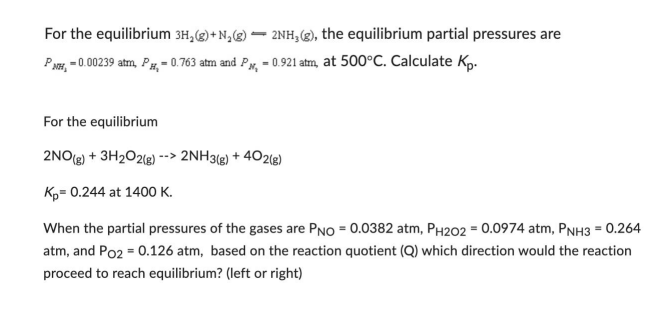For the equilibrium 3H₂(g) + PMH, -0.00239 atm, P,-0.763 atm and P,-0.921 atm, at 500°C. Calculate Kp. N₂(g)2NH₂(g), the equilibrium partial pressures are For the equilibrium 2NO(g) + 3H₂O2(g) --> 2NH3(g) + 402(g) Kp= 0.244 at 1400 K. When the partial pressures of the gases are PNO= 0.0382 atm, PH202 = 0.0974 atm, PNH3 = 0.264 atm, and Po2 = 0.126 atm, based on the reaction quotient (Q) which direction would the reaction proceed to reach equilibrium? (left or right)
For the equilibrium 3H₂(g) + PMH, -0.00239 atm, P,-0.763 atm and P,-0.921 atm, at 500°C. Calculate Kp. N₂(g)2NH₂(g), the equilibrium partial pressures are For the equilibrium 2NO(g) + 3H₂O2(g) --> 2NH3(g) + 402(g) Kp= 0.244 at 1400 K. When the partial pressures of the gases are PNO= 0.0382 atm, PH202 = 0.0974 atm, PNH3 = 0.264 atm, and Po2 = 0.126 atm, based on the reaction quotient (Q) which direction would the reaction proceed to reach equilibrium? (left or right)
Chemistry: Principles and Reactions
8th Edition
ISBN:9781305079373
Author:William L. Masterton, Cecile N. Hurley
Publisher:William L. Masterton, Cecile N. Hurley
Chapter12: Gaseous Chemical Equilibrium
Section: Chapter Questions
Problem 54QAP: Consider the following hypothetical reaction: X2(g)+R(s)X2R(g) R has a molar mass of 73 g/mol. When...
Related questions
Question

Transcribed Image Text:For the equilibrium 3H₂(g) + N₂(g) 2NH3(g), the equilibrium partial pressures are
PNH, -0.00239 atm, P,-0.763 atm and P,-0.921 atm, at 500°C. Calculate Kp.
For the equilibrium
2NO(g) + 3H₂O2(g) --> 2NH3(g) + 402(g)
Kp= 0.244 at 1400 K.
When the partial pressures of the gases are PNO = 0.0382 atm, PH202 = 0.0974 atm, PNH3 = 0.264
atm, and Po2 = 0.126 atm, based on the reaction quotient (Q) which direction would the reaction
proceed to reach equilibrium? (left or right)
Expert Solution
This question has been solved!
Explore an expertly crafted, step-by-step solution for a thorough understanding of key concepts.
This is a popular solution!
Trending now
This is a popular solution!
Step by step
Solved in 3 steps with 2 images

Knowledge Booster
Learn more about
Need a deep-dive on the concept behind this application? Look no further. Learn more about this topic, chemistry and related others by exploring similar questions and additional content below.Recommended textbooks for you

Chemistry: Principles and Reactions
Chemistry
ISBN:
9781305079373
Author:
William L. Masterton, Cecile N. Hurley
Publisher:
Cengage Learning

Chemistry by OpenStax (2015-05-04)
Chemistry
ISBN:
9781938168390
Author:
Klaus Theopold, Richard H Langley, Paul Flowers, William R. Robinson, Mark Blaser
Publisher:
OpenStax

Chemistry & Chemical Reactivity
Chemistry
ISBN:
9781133949640
Author:
John C. Kotz, Paul M. Treichel, John Townsend, David Treichel
Publisher:
Cengage Learning

Chemistry: Principles and Reactions
Chemistry
ISBN:
9781305079373
Author:
William L. Masterton, Cecile N. Hurley
Publisher:
Cengage Learning

Chemistry by OpenStax (2015-05-04)
Chemistry
ISBN:
9781938168390
Author:
Klaus Theopold, Richard H Langley, Paul Flowers, William R. Robinson, Mark Blaser
Publisher:
OpenStax

Chemistry & Chemical Reactivity
Chemistry
ISBN:
9781133949640
Author:
John C. Kotz, Paul M. Treichel, John Townsend, David Treichel
Publisher:
Cengage Learning

Chemistry & Chemical Reactivity
Chemistry
ISBN:
9781337399074
Author:
John C. Kotz, Paul M. Treichel, John Townsend, David Treichel
Publisher:
Cengage Learning

Chemistry
Chemistry
ISBN:
9781305957404
Author:
Steven S. Zumdahl, Susan A. Zumdahl, Donald J. DeCoste
Publisher:
Cengage Learning

Chemistry: An Atoms First Approach
Chemistry
ISBN:
9781305079243
Author:
Steven S. Zumdahl, Susan A. Zumdahl
Publisher:
Cengage Learning